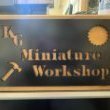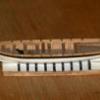-
Posts
13,159 -
Joined
-
Last visited
Reputation Activity
-
 druxey got a reaction from kgstakes in Spindle chair by kgstakes - FINISHED - 1/12th scale
druxey got a reaction from kgstakes in Spindle chair by kgstakes - FINISHED - 1/12th scale
Very nicely done. It 'turned' out well!
-
 druxey got a reaction from Freddy Hutson in Norwegian Sailing Pram by Zack Soderquist - Model Shipways - Scale 1:12
druxey got a reaction from Freddy Hutson in Norwegian Sailing Pram by Zack Soderquist - Model Shipways - Scale 1:12
I suppose the question is whether the bow transom will bother you. If so, changing it will be a good exercise in correcting things. Most, if not all of us, have a bottle of rubbing alcohol handy for ungluing things. For instance, just yesterday I unglued an item twice and re-made it for the third time because I knew it would bother me if I didn't correct it.
-
 druxey got a reaction from chris watton in Sovereign of the Seas: square tuck or round tuck?
druxey got a reaction from chris watton in Sovereign of the Seas: square tuck or round tuck?
Perhaps part of the problem is conflating excellent draftsmanship with researched historical accuracy. The two are not always mutually inclusive. I would tend to accept both Frank Fox and Richard Ensor's work with less question than John McKay's. For instance, there are questionable items in the AOTS book by McKay and Coleman. Although beautifully delineated, for one instance, joggled deck planking was of later origin than 1779.
A good friend of mine, the historian Karl Kessler, declared: "This is a very small book. Read elsewhere and read critically, always."
-
 druxey got a reaction from Old Collingwood in Spindle chair by kgstakes - FINISHED - 1/12th scale
druxey got a reaction from Old Collingwood in Spindle chair by kgstakes - FINISHED - 1/12th scale
Very nicely done. It 'turned' out well!
-
 druxey got a reaction from Canute in Spindle chair by kgstakes - FINISHED - 1/12th scale
druxey got a reaction from Canute in Spindle chair by kgstakes - FINISHED - 1/12th scale
Very nicely done. It 'turned' out well!
-
 druxey reacted to Some Idea in Le Rochefort by No Idea - 1/24th Scale - First POF Build
druxey reacted to Some Idea in Le Rochefort by No Idea - 1/24th Scale - First POF Build
druxey, dvm27 and SaltyScot - thanks for the comments! It's nice to know that it's not just me that has had to resolve earlier issues.
After I built the quarter deck I was surprised just how much it changes the entire look of the ship. It just looks so much more complete and solid which was just another piece of encouragement to move forward.
Mark
-
 druxey got a reaction from king derelict in Spindle chair by kgstakes - FINISHED - 1/12th scale
druxey got a reaction from king derelict in Spindle chair by kgstakes - FINISHED - 1/12th scale
Very nicely done. It 'turned' out well!
-
 druxey got a reaction from Ryland Craze in Yacht Mary by catopower - FINISHED - Mamoli Dusek - 1:54 - An Inherited Model
druxey got a reaction from Ryland Craze in Yacht Mary by catopower - FINISHED - Mamoli Dusek - 1:54 - An Inherited Model
Another time, you might want to consider using SilkSpan....
-
 druxey got a reaction from Jack12477 in Spindle chair by kgstakes - FINISHED - 1/12th scale
druxey got a reaction from Jack12477 in Spindle chair by kgstakes - FINISHED - 1/12th scale
Very nicely done. It 'turned' out well!
-
 druxey reacted to kgstakes in Spindle chair by kgstakes - FINISHED - 1/12th scale
druxey reacted to kgstakes in Spindle chair by kgstakes - FINISHED - 1/12th scale
Completed the spindle chair I've been working on. Had fun building it and turning all the turnings on the Taig lathe. Learned a lot about turning with this lathe and what not to do and what you can do with this lathe.
Enjoy the pictures!!
-
 druxey reacted to kgstakes in Spindle chair by kgstakes - FINISHED - 1/12th scale
druxey reacted to kgstakes in Spindle chair by kgstakes - FINISHED - 1/12th scale
Turning all done, chair glued up. Stain and finish next and then make the woven seat cushion.
-
 druxey reacted to kgstakes in Spindle chair by kgstakes - FINISHED - 1/12th scale
druxey reacted to kgstakes in Spindle chair by kgstakes - FINISHED - 1/12th scale
Few more pieces done have just a few more and then glue up, put a finish on it and then start on seat cushion.
-
 druxey reacted to kgstakes in Spindle chair by kgstakes - FINISHED - 1/12th scale
druxey reacted to kgstakes in Spindle chair by kgstakes - FINISHED - 1/12th scale
Test fit most of the pieces still have the small backrest pieces to turn. It’s coming out great, at least I think so for basically my first big ok small turning project.
-
 druxey reacted to kgstakes in Spindle chair by kgstakes - FINISHED - 1/12th scale
druxey reacted to kgstakes in Spindle chair by kgstakes - FINISHED - 1/12th scale
Started assembling sides are together
-
 druxey reacted to gsdpic in Porsche 911 GT3 RS by gsdpic - FINISHED - Tamiya - 1/24 - PLASTIC
druxey reacted to gsdpic in Porsche 911 GT3 RS by gsdpic - FINISHED - Tamiya - 1/24 - PLASTIC
Thanks all for the likes, the comments, and for following along on this quick build. I've now completed the Porsche 911 GT3 RS. Those sharp-eyed among you might notice that there is no carbon fiber on the mirrors. That was a bit of a fail so I just painted the top gloss black and left it at that. Each mirror top half had 3 carbon fiber decals to apply. The first mirror went ok, though the top decal was not very smooth, despite using decal setting solution and a hair dryer to soften it with some heat. I then went on to the second mirror and while using the hair dryer, the blast of air caught the edge of the decal and blew it off the mirror to who-knows-where. I searched around a bit for it but could not find it so at that point gave up on the carbon fiber on the mirrors. Oh well. Otherwise, I am generally pleased with the results. There are still a few minor flaws with the paint work on the body but nothing major. Oh, I also had some problems with the decals on the wheels....there is supposed to be a tiny round decal on the wheel center lock. Two of them came off during assembly so I just painted the top of the center lock black. And now looking at the pictures I see that a third one of those decals went away, so I need to paint that one black too.
Oh, did not mean to be that long-winded. Here are the final pictures.
-
 druxey reacted to Jim Lad in Mystery wire rope across chainplates on 1920s trading schooner - what is it?
druxey reacted to Jim Lad in Mystery wire rope across chainplates on 1920s trading schooner - what is it?
Aha! Good research backed up by dogged perseverance solves the problem!!
John
-
 druxey reacted to Tony Hunt in Mystery wire rope across chainplates on 1920s trading schooner - what is it?
druxey reacted to Tony Hunt in Mystery wire rope across chainplates on 1920s trading schooner - what is it?
Aha. What a modern yachtsman calls a preventer. Why didn't I think of that? I've used one hundreds of times!
-
 druxey reacted to wefalck in Mystery wire rope across chainplates on 1920s trading schooner - what is it?
druxey reacted to wefalck in Mystery wire rope across chainplates on 1920s trading schooner - what is it?
That makes perfect sense 👍🏻
-
 druxey reacted to Ian_S in Mystery wire rope across chainplates on 1920s trading schooner - what is it?
druxey reacted to Ian_S in Mystery wire rope across chainplates on 1920s trading schooner - what is it?
I think we may have all been barking up the wrong tree. The following photo, which I've only just found (online at the Tasmanian Archives, I thought I'd exhausted that source years ago but here we are ... ) shows the rope in question. It is hooked to the single-sheave block of the foremast boom tackle of the gaff sail rig. So it's a part of the running rigging. I think what is in all the photos I've shown would be called a boom tackle pendant (or pennant).
It relates to an explanation of boom tackles (also called boom guys) in Chapelle's "American Fishing Schooners" (p.357): "Their purpose was to hold the booms outboard when running before the wind the vessel rolling." (sic, seems to be missing a word or two). In the photo I've attached below, we see the single-sheave block with a hook that if not in use would be hooked to an eye under the boom a little aft of the boom jaws. The other block in the tackle is a double sheave block, hooked and moused to a wye band near the sheet wye toward the end of the boom (can't see that in the photo, but Chapelle's diagram shows it, as do Figs 10-12 to 10-14 of Bennet's Schooner Sunset. In Chapelle's description, "To guy the mainboom, the single block was unhooked and brought to the rail near the aftermost fore shroud and hooked into a staple on the rail cap. The fall was then led off and set up, then belayed on the pin in the boom jaws.". So there should be a pin in the boom jaws in the photo below, but it's obscured, so you can't actually see it.
Chapelle goes on, and his next comment reflects what is also clearly depicted in Bennet's Fig 10-13, which shows the British version of the boom tackle pendant (or pennant): "The foreboom guy led to a staple on the bow chock rail ... the fall belaying on a cleat on the side of the foreboom. Racers sometimes had pendants for guys to hook into, to avoid overhauling the tackles, which were very long on a large schooner."
So, unless someone raises objections, there we have it. These southeast Australian skippers in their sweet picturesque old-time sailing vessels, the seas already full of steamers and motor vessels, when out on the seas far from land where nobody was watching, turned into insatiable speed freaks who held the booms as far outboard as they could, by extending the boom tackle on long outboard pendants.
The photo below, in full and at higher resolution is at https://libraries.tas.gov.au/Digital/LMSS761-1-595
So we have it? I'd be interested if anyone can provide more detailed references to boom tackles.
-
 druxey reacted to rwiederrich in Staghound 1850 by rwiederrich - 1/96 - Extreme Clipper
druxey reacted to rwiederrich in Staghound 1850 by rwiederrich - 1/96 - Extreme Clipper
First coat of primer white. Before I install the stanchions.
Rob
-
 druxey reacted to Chuck in Syren Ship Model Company News, Updates and Info.....(part 2)
druxey reacted to Chuck in Syren Ship Model Company News, Updates and Info.....(part 2)
The Lanterns are in production over the next few days.
I thought it would take a while to write the instructions but this was the quickest lantern I ever built.
Its a three part lantern.
You get the bottom/window part 1
The top "Lid" part 2
and the Glass window insert part 3.
The photo below shows one finished lantern with frosted glass insert. You can also see a second lantern under construction. This has a clear glass insert. Note the two inserts. One is frosted which is how they all appear when 3d printed. Any of you who have ever tried to 3D print clear resin knows that at best you get this frosted appearance after washing and curing.
1.But if you prefer a clearer glass insert that is easy enough. Behind the lanterns you can see some water-based Polycrylic. You should use gloss or high gloss but all I had was ultra flat and it still worked very well. Just use a very clean brush to coat the glass insert inside and out. I used a helping hands to secure the glass insert and just brush the stuff un. A THIN COAT is all you need. Dont touch it...dont paint a second coat etc. Let it dry fully before touching it. It works like magic and instantly make your piece clear. Now if I used gloss it would have been like clear glass. But honestly, the frosted original looks very good as is also. You can see an original frosted and a varnished insert in the photo.
2. Insert the glass into the lantern body. It can only fit one way...no glue needed. Just do a press fit. Make sure it is seated all the way in there. It is printed to be a snug fit. After you insert the glass part you can flip the lantern upside down and apply gentle pressure if you want to really seat it in there. If the glass still protrudes higher than the lantern ....which it might...just use a sanding stick that is flat to sand it down level and flush with the lantern top. In fact you will absolutely have to do this anyway to get a flat surface in the next step.
3. Take a flat sanding stick or emory board and sand the top of the lantern flat to accept the top..."lid" or roof. There will be some little sprue marks and unevenness because of the 3D printing supports. Sand it all down flat. The hardest part is getting all the dust out and keeping the interior clean. Use one of those "air in a can" sprayers. Then repeat and sand the bottom of the lid flat for the reason. You want a nice tight fit between the two when you glue them together.
4. Glue the roof lid onto the lantern. Dont use a lot of glue. You dont want it squishing out or making the glass dirty. Yes I did use the smallest drops of medium CA. NOW.....this is important, remember to glue the top on facing the right direction. You can see how the lantern is angled so nicely and the top should be easy enough to figure out which way it should go. BUT....it isnt. Take it from me. And its a devil to separate so do a dry run first otherwise you may be buying a new lantern mini kit.
Thats it.....you can make and fashion the crank out of heavy square or round wire or rod. Just follow your plans as they may all be a little different. Use a hollow tube if you want to wire up an led flickering thinga ma bob.
5. It is optional but you can paint the inside of your lantern if you wish. A dark gray or even red based on contemporary examples. The exterior can be left natural and as is, or you can paint portions of that as well. Its up to you.
Darker Swiss pear maybe?? But a tad lighter than my rigging blocks. I didnt want to go too dark. With a frosted insert.
-
 druxey reacted to Trussben in HMS Portland 1770 by Trussben - Portland Scale Ship Co. - 1:48 - 50 gun 4th rate
druxey reacted to Trussben in HMS Portland 1770 by Trussben - Portland Scale Ship Co. - 1:48 - 50 gun 4th rate
I glued together the eight included bulkhead former uprights ready for the build board and then glued the “rabbit” strip to the former as well.
Now to work on the Knee!
-
 druxey reacted to archjofo in La Créole 1827 by archjofo - Scale 1/48 - French corvette
druxey reacted to archjofo in La Créole 1827 by archjofo - Scale 1/48 - French corvette
@shipman
@SaltyScot
Hello,
Thank you very much for the nice comments.
I'm very happy. Thanks also to everyone else for the many likes.
Continuation: Fore yard – Bowlines / Boulines
I've also since read up on the arrangement of the bowline bridles in the contemporary specialist literature "Manuel de Greement" by F. A. Coste from 1829, starting on page 167, and it fits. The only thing is that it refers to thimbles through which the individual rope limbs are threaded.
I also looked again in Marquardt, which also covers the rigging of French ships, although again only up to the end of the 18th century.
If I now incorporate the aforementioned contemporary illustrations from the early 19th century and models from the Paris Museum into my considerations, I come to the conclusion that the bowline bridles on my corvette could well have looked the way I have since attached them to the fore yard.
I can't clearly verify the attachment of the bowlines without sails for the French, as shown in the K. Schrage's book – Rundhölzer, Tauwerk und Segel – . But I think it's quite realistic that the French did it the same way as the British.
I'm currently building a jig to make rope coils for the belaying pins.
I imagine it might look like this:
More on that soon...
-
 druxey reacted to rwiederrich in Staghound 1850 by rwiederrich - 1/96 - Extreme Clipper
druxey reacted to rwiederrich in Staghound 1850 by rwiederrich - 1/96 - Extreme Clipper
Worked on adding the monkey rail. I’ll weather it after it fully dries. The onto the decking and bulwarks
Rob
-
 druxey reacted to catopower in Yacht Mary by catopower - FINISHED - Mamoli Dusek - 1:54 - An Inherited Model
druxey reacted to catopower in Yacht Mary by catopower - FINISHED - Mamoli Dusek - 1:54 - An Inherited Model
Hi Druxey, I'm actually figuring on trying that on my HMS Wolf build, which I want to get back to soon. I want to try some furled sails and figure it will also be easier to do with silkspan. Also, the smaller scale of that model really calls for it (1/72).
For the Mary, in part, I wanted to build it the way I think the original builder would have done, though I have no actual evidence that he would have even added sails or what type. It's just more of a judgement from the "feel" of his building style.
Even the way I'm making the sails now doesn't seem quite right for his model. But, I needed to satisfy myself too. These cloth sails are somewhere in between.








